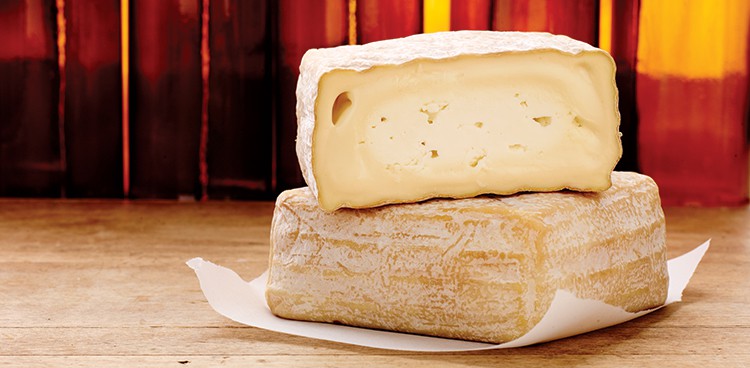
An exploration of beer-washed cheeses should begin in the hills of France and Belgium. This one does, if only to illustrate how far American cheesemakers have journeyed from European tradition.
While the process was born out of necessity, innovative producers across the United States are embracing the practice out of personal passion for local suds, respect for the growing craft-brewing movement, and, most importantly, their desire to tease nuanced flavors from a humble piece of cheese.

Keswick Creamery The Stinky Elf
A Nod to the Monks
Monks in the Middle Ages followed highly regimented schedules: They made cheese immediately after milking, according to historian Paul Kindstedt, who recounts the monastic origins of European washed-rind cheeses in his books. Resulting high-moisture wheels were low in acid, creating ideal conditions for yeast and bacteria to develop on the rinds during aging; brine washing further encouraged this growth, as microbes require a certain level of salinity and moisture to flourish. Since monks were the de facto brewers and vintners of the period, it was only a matter of time until they started experimenting with beer and wine in the wash. It’s commonly thought that this addition was for preservation purposes—the sugars in alcohol fed yeasts, keeping undesirable microflora at bay. Another possibility: Alcohol can impart meaty flavors to cheese, which would be particularly appealing to brothers who swore off meat for Lent.
Savory, beefy, and complex flavor profiles certainly hold the imaginations of many domestic makers turning out beer-washed cheeses, yet none of the producers I interviewed credit a European cheese as a primary source of inspiration. (The most common European examples of the style available in the US are from Belgium’s Chimay, which makes a half-dozen cheeses, only two of which are actually doused in their own beer.) So, while the style is undeniably a European invention, it’s not tradition that excites today’s American beer-washed cheese producers. It’s the creative potential unearthed when brews meet rinds.

Mt. Townsend Creamery Off Kilter
The Flavor Factor
Sitting down to taste 24 beer-washed cheeses from states spanning Vermont to Oregon, I can’t tell they’ve been bathed in beer. Most look like standard washed-rind stinkers: soft and runny to semisoft and springy with a tacky orange or ruddy rind. A few outliers are firm. One has a dry, crosshatched natural rind; another showcases a pinkish, fruity-smelling crust. Surely, I think, beer will make its presence known in the tasting. An IPA-washed cheese might offer up lean, bitter, and vegetal flavors while the stout- and porter-rinsed cheeses might be chocolatey and roasty. Not so.
It isn’t until I speak with several makers that I arrive at an a-ha moment, courtesy of Mt. Townsend Creamery CEO Ryan Trail. “I don’t really get a lot of [the beer] flavor,” he says of the company’s Off Kilter, washed in Pike Brewing Company Kilt Lifter Scotch-style ale. “It’s not a flavoring. We think about it as setting the right conditions for the microflora to grow.”
Peter Jenkelunas, caves manager at New York’s Murray’s Cheese, echoes the sentiment. In his stewardship of The Other Stephen, a triple-cream Four Fat Fowl St. Stephen washed in Other Half Brewing Company Short, Dark & Handsome stout, he finds that “the wash plays a background role,” with flavor determined more directly by a cheese’s culture blend. However, if the beer delivers “a lot of sugars, you’ll have higher yeast activity. It affects how vigorous the bacterial growth is on the surface of the cheese.”
In other words, beer has a critical influence on cheese, but there isn’t a direct correlation between a beer’s flavor and a beer-washed cheese’s flavor. The presence of beer, either on its own or as part of a brine wash, creates conditions in which other microbes will propagate. It changes a rind’s levels of moisture, salt, and acidity, which impact a cheese’s maturation cycle and, ultimately, its lifespan. It delivers, as Alemar Cheese Company founder Keith Adams puts it, “an alchemy of flavors between beer and cheese. You can’t necessarily taste the beer.”

Old Chatham Sheepherding Company & Crown Finish Caves Trifecta
Originally, Germer tried an 11 percent alcohol-by-volume (ABV) beer but found it accelerated the cheese’s degradation. Other trials ended with wildly different results. A sheep’s milk camembert washed in chocolate stout boasted notes of broccoli while the same cheese washed in hard cider tasted like “a bologna sandwich—the sweetness of white bread with meatiness and mustard. It wasn’t what you’d expect,” she says. In each instance, Germer’s findings were the same: The final cheese never tasted like the beer it was washed in, but certain beers encouraged the development of desirable flavors.
Every cheesemaker interviewed describes an unpredictable discovery process in choosing a beer wash, but all mimic Germer’s experience at Crown Finish Caves: “It took a lot of trial and error to find the right beer—[considering how they affect] flavor, rind development, and paste breakdown,” she says. “Not every beer is created equal [for washing cheeses].”

Sartori Raspberry BellaVitano
“A rising tide raises all boats”
Once upon a time, medieval monks washed their cheeses in beer out of necessity and practicality. Modern American cheesemakers have run with the style, motivated by creative spirit and recognition of craft brewers as cohorts in a burgeoning artisan revolution. To wit: In 2014, the number of operating craft breweries in America grew 19 percent from 2013, earning $19.6 billion or 19.3 percent of the total beer market, according to the Brewers Association. Meanwhile, according to data from the US Census Bureau’s 2012 Economic Census, the number of small cheesemaking operations (defined as employing up to 19 people) rose by 28 percent between 2007 and 2012.
It helps that many American cheesemakers prefer to drink beer with their cheese. “A lot of people think of pairing wine and cheese,” says Trail of Mt. Townsend. “I wish I could remember who made this comment, but the cows aren’t eating grapes. The cows are eating barley.” Introducing beer into the wash was an obvious step.
Universally, cheesemakers source beer that is unfamiliar to the public, save for hardcore suds geeks or local residents. That’s because they turn to neighbors for ales and lagers. While logistics play a part in this choice—several producers mention the benefits of washing with freshly brewed beer that hasn’t traveled—it’s more about how “a rising tide raises all boats,” says Sam Kennedy, co-cheesemaker at The Farm at Doe Run. Many fledgling artisan cheesemakers and brewers treasure “collaboration and camaraderie,” he adds.
Again and again, cheesemakers speak of craft brewers as their supporters and friends. Sarah Marcus, owner
of Briar Rose Creamery in Portland, Ore., washes her goat cheese Lorelei in Deschutes Brewery Black Butte Porter, first and foremost because the brewpub buys and serves her cheeses. Plus, porter lends the rind its signature rusty hue while permeating the cheese with lingering flavor. (Marcus tried washing the cheese with another brewery’s IPA but didn’t prefer the finished product.)

Mt. Mansfield Creamery Inspiration
And when Stan Biasini, owner and cheesemaker at Vermont’s Mt. Mansfield Creamery, was just starting out, he decided to differentiate his offerings by washing his Inspiration cheese with Mountain Holidays in Vermont bock produced by standout Rock Art Brewery. He has also used beer from The Alchemist and the Vermont Pub and Brewery.
“I’ve always been a firm believer in joining [up with] companies that are already well established,” he says. When Rock Art named Inspiration as a top pairing on its bottle label, Biasini was ecstatic. “How good is that, to have someone advertise for you?” Working with local craft brewers provided an opportunity to reach an existing audience of food enthusiasts and tap into their marketing power.
John Scaggs of Colorado’s Haystack Mountain Goat Dairy praises the business opportunity in joining forces with fellow producers, as Haystack has with Oskar Blues Brewery to make its G’Knight imperial red IPA-washed goat cheese, A Cheese Named Sue. “As a cheese marketer I’m thrilled that beer and cheese work so beautifully together,” he says. “We’re seeing so many more collaborations in areas where cheesemakers and craft breweries are popping up. We’re all looking for ways to present these experiences to our customers.”
Cheese and beer fans, it seems, face a tall task in trying them all.

Haystack Mountain Goat Dairy A Cheese Named Sue
Tasting Notes
Raspberry BellaVitano
- Sartori
- Plymouth, Wis.
- Pasteurized cow’s milk
WASHED IN: New Glarus Brewing Company Raspberry Tart
The original Italian-inspired BellaVitano is firm, sweet, and buttery. Washed in raspberry ale, it turns tart, fruity, and bright—insanely crowd-pleasing.
The Stinky Elf
- Keswick Creamery
- Newburg, Pa.
- Raw cow’s milk
WASHED IN: Trub (spent yeast) from Tröegs Independent Brewing The Mad Elf Ale
Imagine a taller Taleggio with an imposing, rustic rind covered in patches of what appears to be brown lichen. Amp up Taleggio’s telltale comforting flavors of yeast, seawater, and apricot, and behold: The Stinky Elf.
Inspiration
- Mt. Mansfield Creamery
- Morrisville, Vt.
- Raw cow’s milk
WASHED IN: The Vermont Pub and Brewery Burly Irish Ale (or Rock Art Brewery Mountain Holidays in Vermont or The Alchemist Heady Topper, depending on the season)
This Tomme de Savoie lookalike has a dry, sandy crust over a dense interior and it tastes of farm: barnyardy and lactic.
The Other Stephen
- Four Fat Fowl / Murray’s Cheese Cavemaster Reserve
- Stephentown, N.Y. / New York, N.Y.
- Pasteurized cow’s milk
WASHED IN: Other Half Brewing Company Short, Dark & Handsome
A real wolf in sheep’s clothing, this cheese has a white-mold rind that looks bloomy, not washed in stout, and a paste that appears flaky and chalky yet smears like butter—all with addictive, mellow notes of macaroni-and-cheese powder.
Lorelei
- Briar Rose Creamery
- Dundee, Ore.
- Pasteurized goat’s milk
WASHED IN: Deschutes Brewery Black Butte Porter
This brown-mottled 10-ounce square with a bulging creamline and a chalky interior has notes of fermented fruit near the rind and complex coconut flavors in the paste.
A Cheese Named SueA Cheese Named Sue
- Haystack Mountain Goat Dairy
- Longmnt, Colo.
- Raw goat’s milk
WASHED IN: Oskar Blues Brewery G’Knight
This imperial red IPA–washed double-stacked hockey puck with a floral aroma is reminiscent of goat tommes found in the French Pyrenees: dense and chewy with intense notes of stone fruit, mostly apricot and peach.
Off Kilter
- Mt. Townsend Creamery
- Port Townsend, Wash.
- Pasteurized cow’s milk
WASHED IN: Pike Brewing Company Kilt Lifter
A buoyant, springy paste encased in the palest of orange rinds, this cheese is speckled with blue mold. It’s at once mild, mellow, sweet, and malty.
Trifecta
- Old Chatham Sheepherding Company / Crown Finish Caves
- Old Chatham, N.Y. / Brooklyn, N.Y.
- Pasteurized sheep’s milk and cow’s cream
WASHED IN: Threes Brewing Wandering Bine
Boasting a beautifully thin rind and a texture akin to tempered butter, this cheese has a funky aroma but a flavor of pure boiled peanut.
Bathed in Victory series
- The Farm at Doe Run
- Unionville, Pa.
- Pasteurized cow’s milk
WASHED IN: Victory Brewing Company beers
All four varieties in this beer-washed series exhibit a smooth, creamy-dense, eyeless paste with a tacky, orange sherbet–colored rind. The rounds bathed in HopDevil India Pale Ale and Golden Monkey are mild and fruity; the DirtWolf Double IPA–smothered selection is yeasty and barnlike; and the Storm King Imperial Stout–washed wheel is nutty good.
Good Thunder
- Alemar Cheese Company
- Mankato, Minn.
- Pasteurized cow’s milk
WASHED IN: Surly Brewing Bender
The intense appearance of this deep-orange and russet cheese with a thick, tacky rind belies a succulent, whipped paste with briny, brothy, bready flavors.




